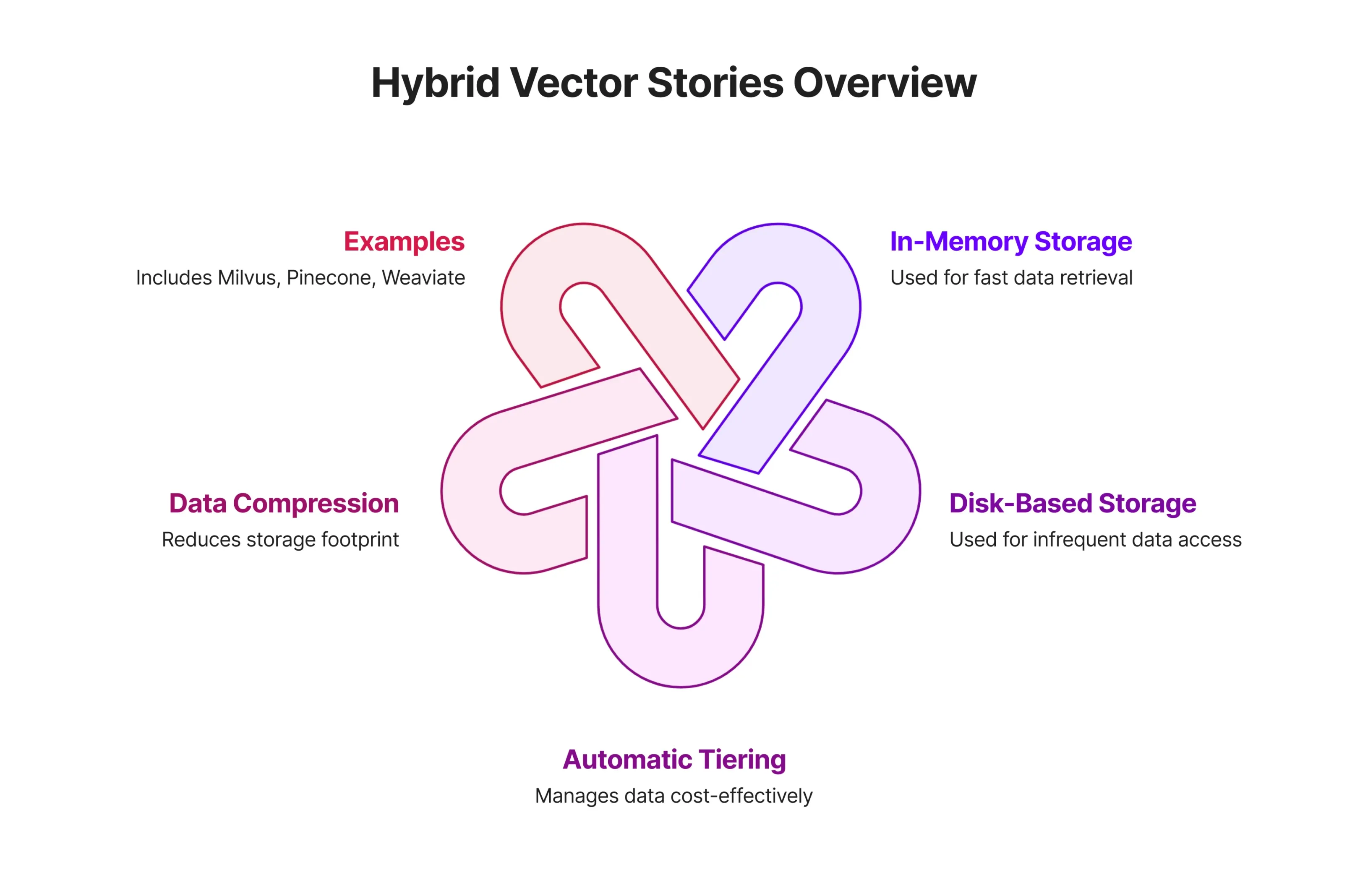The Different Types of Vector Stores and Their Role in Data Retrieval
Feb 17, 2025
In the current era of technological advancements, it is evident that AI has revolutionized the operations of industrial tasks as well as day-to-day activities. One of the significant means of data retrieval for AI and machine learning applications is vector stores to which specifically, Bittensore vector store has made an extraordinary entrance to the technological field. Acting as a cutting-edge resolution for innovativeness, Bittensore vector store plays a crucial role in storing vectors in memory for the upsurge of AI performance as well as real-time data access. It is essential to recognize that storing vectors in memory promotes memory efficiency, primarily for large datasets.
Decent vector storage is able to assure efficient retrieval operations whilst running on several hardware in an optimal manner. As such, this article will proceed to explore the types of vector stores, their special features, as well as how Intertec is able to leverage such advanced technologies for its clients’ benefits.
Understanding Vector Stores: A Modern Approach to Data Retrieval
Essentially, a vector is a high-dimensional representation of data to which a vector store is a specially designed database or structure that stores and manages vectors. Such data can be in the form of words, images or other complex data forms. On a similar note, vector embeddings are numerical representations of data that can take place in the form of texts, images, or audio to which each item is mapped to a vector. As an overview, vector embeddings operate by means of its dimensionality and it plays a vital role in representing data in a meaningful manner by simplifying complex data, capturing semantic relationships as well as being equipped with interchangeable representations.
Within the technological industry, data is commonly transformed into vectors by means of algorithms such as word, sentence or image embeddings whereby they allow systems to retrieve similar information pursuant to the vector representations. The key concepts of storing generated vectors are that it powers complex AI systems such as semantic search or recommendation systems to which it benefits the process of machine learning and advancement for society’s benefit as a whole. This feature distincts itself from traditional databases as it has the ability to store data in high-dimensional forms rather than only structure data in the form of strings, numbers, and dates in tabular forms.
Vector stores are able to carry out semantic searches whereby the input and the output are not based on exact matches but instead on similarities. Traditional databases on the other hand are only capable of finding exact matches or range queries to which the output would be more limited in comparison. As such with regards to efficiency in performances, the scale tips towards vector stores having a more optimal performance as it is designed for similarity searches with speed and accuracy at a large scale. Vector stores are able to perform at such high efficiency making it cardinal for AI-powered applications that operate at a great scale.

Types of Vector Stores and Their Use Cases
1. In-Memory Vector Stores
In order to further comprehend the role played by vector stores, it is pivotal to recognize that there are several types of vector stores with distinct features and purposes. One of the types of vector stores is the in-memory. This form of vector store best applies when speed and scalability within memory limits are needed as it eradicates the necessity for disk I/O, to which it results in lower latency during its operations.
At the same time, it offers the advantage of allowing efficient retrieval of vector embeddings during similarity searches. However, despite allowing ultra-fast access, it falls short in terms of having limited memory space to which scaling beyond the vacant RAM may lead to the need of distributed systems or hybrid solutions that utilizes in-memory and disk-based storage. As an in-memory vector store is designed to be volatile, it also means it has the potential risk of losing data should the system crash or restart. Although it has its limitations, technological solutions remain in place to address them such as periodic snapshots or replication to disk.
2. Disk-Based Vector Stores
Another form of vector stores would be disk-based for the purpose of scalability and cost-efficiency. In times where large datasets are in place, particularly for machine learning, semantic searches and much more. As high-dimensional data are at stake, the disk-based vector stores are able to efficiently conduct quick similarity searches by means of specialized indexing techniques despite having the vectors being stored on disk.
However, disks offer the advantage of having limitless capacity to manage massive scales of vectors. Unlike in-memory vector stores, the disk-based vector store safeguards data persistence when the system crashes or restarts, hence offering security over sensitive information.
For industries managing large scale datasets, the disk-based vector storage takes the spotlight in storing endless amounts of vector data at minimal expense. It should however be highlighted that a disk-based vector storage has slower access time in comparison to in-memory vector stores due to its capacity as well as complexity in index management and the need for persistence in distributed systems, it remains an efficient component for large-scaled applications to utilize.
3. Distributed Vector Stores
Aside from the in-memory and disk-based vector stores, industries with vast datasets are also able to utilize the distributed vector stores to optimize its features of fault tolerance, scalability as well as performance for largely scaled data operations. It is optimally designed to be replicated across multiple nodes as a safeguard to continuously operate in the event a machine or network malfunctions. With its implemented feature of having multiple nodes, it is able to ensure that no node is overloaded due to its load balancing mechanisms that are in place to consistently promote efficient query responses.
Furthermore, it distributes large datasets into smaller segments, also known as shards, for the purpose of better management of data to be stored into different nodes within its distributed system. This allows the system to have room for growth without the concern of searching through vast scales of data. As an insight to how this is achieved, the distributed vector stores operate by ingesting data to which it then distributes indexing techniques to search for similar vectors.
Lastly, once a similarity search is conducted, the system will proceed to comb multiple nodes for the relevant shards in a parallel manner which results in a speedier process at a cost-efficient rate. This is ideal for real-time applications such as recommendation systems or personalized AI solutions where the parameters of the query are large. Nonetheless, the feature of having multiple nodes requires storage as well as an efficient network in order to manage the communication between the nodes.
4. Specialized Vector Stores
Specialized vector stores on the other hand are typically used for industry-specific data. Unlike in-memory, disk-based or distributed vector stores, it is designed to manage niche application requirements dealing with vector embeddings that act as a tailored solution for handling specialized information. Industries that utilize this system range from healthcare, e-commerce and even natural language processing, to which all these respective industries share the same goal of managing large datasets. The specialized vector stores are constructed with specialized indexing structure to assist with efficient similarity searches of high-dimensional spaces which include Hierarchical Navigable Small World Graph (HNSW), Inverted File (IVF), and even Product Quantization (PQ).
As specialized vector stores are constructed to assist with industrial tasks, it is able to seamlessly integrate itself with existing machine learning models which are utilized to generate embeddings. It is essentially ideal for day-to-day tasks such as semantic searches, recommendation systems, image retrieval and even speech recognition to which these features are powered by advanced indexing algorithms for specific sector needs.
5. Hybrid Vector Stores
In light of the existing vector stores, the hybrid vector stores stands out as an efficient storage approach by means of integrating both the in-memory and disk-based storage architecture to manage vector data. The combination of these two components allow a seamless workflow of retrieval operations. For instance, in-memory storage is utilized for fast retrieval times, whereas the disk-based storage is used for infrequently accessed vectors.
These two vector stores work hand-in-hand with the automatic tiering mechanism to perform cost-efficient data management and retrieval whilst compressing data to reduce storage footprint. Examples of hybrid vector stores are Milvus, Pinecone, and Weaviate, to which these systems operate in ensuring low-latency performance for real-time AI applications. It goes without saying that due to the combination of two distinct vector stores, the implementation process of the hybrid integration is highly complex to the extent that additional system overhead may be introduced.

Spotlight on Bittensor Vector Store
Taking into consideration the types of vector stores, each category can be observed to serve distinct roles and purposes for its users depending on the unique needs and requirements. Bittensore vector store poses as a unique decentralized platform amongst the range of vector stores in allowing the management of high-dimensional vector data that is unlike traditional approaches. It operates on the blockchain using cryptographic mechanisms in order to safeguard the security, incentivization and decentralized governance.
With its architecture, it allows the collaboration between dissimilar AI models across assorted nodes on its network, making it a groundbreaking AI-driven solution. As a blockchain-based platform, Bittensore vector stores have the capability to safeguard the vital elements of security and data privacy, especially in the form of encryption and cryptographic proofs in order to distinguish malicious activities at the quickest instance. Aside from such, it has the competitive edge of having an incentivized ecosystem that motivates its users to consistently improve models and data which formulates it as a self-sustaining platform. It should be noted that users that wish to contribute require a certain level of expertise on technical knowledge due to its complexity.
Furthermore, it offers the advantage of scalability to handle large-scaled datasets as well as its transparency for open collaboration between users. Despite encountering challenges such as having higher latency or requiring to ensure data quality across the assorted nodes consistently as well as the regulatory issues relating to data ownership concerns, it remains as a novel approach to machine learning that fosters the spirit of collaboration.
Conclusion
As AI-based innovations continue to emerge within the markets as a solution to daily inconveniences, vector stores remain as a reliable approach to handle complex and vast amounts of datasets albeit for personal or industrial use. Bittensore vector store can be classified as a cutting-edge tool that stands out amongst the existing vector stores due to its unique architectural features on the blockchain as well as its ability to tackle aspects where traditional vector store approaches fall short. In the days of modern AI and data retrieval, advanced solutions such as Bittensore itself may potentially put users at a competitive position within the markets in order to transform respective operations whilst having the room for operational growth. Intertec has been well-equipped with the expertise in implementing advanced vector store solutions such as Bittensore. By reaching out to Intertec, businesses are already able to take a step ahead in differentiating themselves from the industrial scene.


Stefan Gligorov
Book a Free Consultation
Trusted by leading businesses worldwide
Book a Free Consultation
You may also like

Towards Perfect ES Query Generation with Elastic-builder
Apr 09, 2020
Velimir Graorkoski

Elastic Builder To The Rescue
Apr 22, 2020
Velimir Graorkoski

Understanding the Most Effective Practices of Remote Working
May 19, 2020
Tanja Zlatanovska